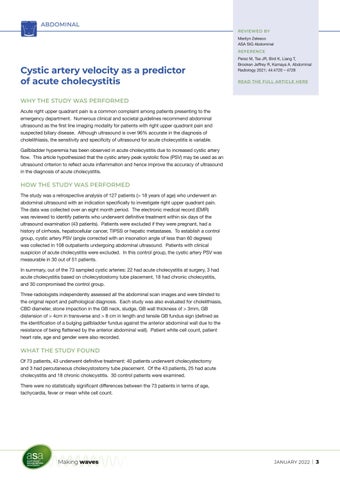ABDOMINAL REVIEWED BY Marilyn Zelesco ASA SIG Abdominal REFERENCE
Cystic artery velocity as a predictor of acute cholecystitis
Perez M, Tse JR, Bird K, Liang T, Brooken Jeffrey R, Kamaya A. Abdominal Radiology 2021; 44:4720 – 4728 READ THE FULL ARTICLE HERE
WHY THE STUDY WAS PERFORMED Acute right upper quadrant pain is a common complaint among patients presenting to the emergency department. Numerous clinical and societal guidelines recommend abdominal ultrasound as the first line imaging modality for patients with right upper quadrant pain and suspected biliary disease. Although ultrasound is over 96% accurate in the diagnosis of cholelithiasis, the sensitivity and specificity of ultrasound for acute cholecystitis is variable. Gallbladder hyperemia has been observed in acute cholecystitis due to increased cystic artery flow. This article hypothesized that the cystic artery peak systolic flow (PSV) may be used as an ultrasound criterion to reflect acute inflammation and hence improve the accuracy of ultrasound in the diagnosis of acute cholecystitis.
HOW THE STUDY WAS PERFORMED The study was a retrospective analysis of 127 patients (> 18 years of age) who underwent an abdominal ultrasound with an indication specifically to investigate right upper quadrant pain. The data was collected over an eight month period. The electronic medical record (EMR) was reviewed to identify patients who underwent definitive treatment within six days of the ultrasound examination (43 patients). Patients were excluded if they were pregnant, had a history of cirrhosis, hepatocellular cancer, TIPSS or hepatic metastases. To establish a control group, cystic artery PSV (angle corrected with an insonation angle of less than 60 degrees) was collected in 108 outpatients undergoing abdominal ultrasound. Patients with clinical suspicion of acute cholecystitis were excluded. In this control group, the cystic artery PSV was measurable in 30 out of 51 patients. In summary, out of the 73 sampled cystic arteries: 22 had acute cholecystitis at surgery, 3 had acute cholecystitis based on cholecystostomy tube placement, 18 had chronic cholecystitis, and 30 compromised the control group. Three radiologists independently assessed all the abdominal scan images and were blinded to the original report and pathological diagnosis. Each study was also evaluated for cholelithiasis, CBD diameter, stone impaction in the GB neck, sludge, GB wall thickness of > 3mm, GB distension of > 4cm in transverse and > 8 cm in length and tensile GB fundus sign (defined as the identification of a bulging gallbladder fundus against the anterior abdominal wall due to the resistance of being flattened by the anterior abdominal wall). Patient white cell count, patient heart rate, age and gender were also recorded.
WHAT THE STUDY FOUND Of 73 patients, 43 underwent definitive treatment: 40 patients underwent cholecystectomy and 3 had percutaneous cholecystostomy tube placement. Of the 43 patients, 25 had acute cholecystitis and 18 chronic cholecystitis. 30 control patients were examined. There were no statistically significant differences between the 73 patients in terms of age, tachycardia, fever or mean white cell count.
Making waves
JANUARY 2022 | 3




